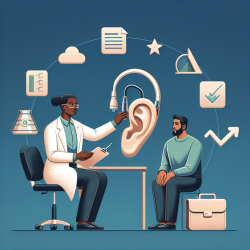The rapid advancement of digital health and learning technologies is reshaping the landscape of speech-language pathology (SLP), phoniatrics, and otolaryngology. A recent interdisciplinary survey study titled Digital Health and Digital Learning Experiences Across Speech-Language Pathology, Phoniatrics, and Otolaryngology: Interdisciplinary Survey Study provides critical insights into the knowledge, use, attitudes, and preferences of professionals and students within these fields.
Here, we explore how practitioners can leverage the findings from this study to improve their skills and create better outcomes for children.
Key Findings
- Knowledge Gaps: The study revealed that familiarity with digital health terms is significantly lower among students and younger professionals compared to their more experienced counterparts. This highlights an urgent need for incorporating digital health topics into clinical training programs.
- Digital Learning Tools: While most respondents were familiar with digital learning tools, there was a significant preference for blended learning models that combine in-person and digital education. The use of digital learning tools can be optimized by ensuring they are interactive and user-friendly.
- Device and Software Use: The primary devices used for digital therapy and learning were computers, smartphones, and tablets. Word processing software, presentation software, and videoconferencing tools were the most commonly used digital systems.
- Attitudes Toward Digitalization: The majority of respondents held positive views toward digitalization in medicine. However, there were concerns about the quality and validity of digital therapy tools, as well as technical difficulties and data privacy issues.
Actionable Strategies for Practitioners
Based on these findings, here are some actionable strategies for practitioners to enhance their digital competencies:
- Incorporate Digital Health Topics into Training: Given the knowledge gaps identified, it is crucial to integrate digital health topics into both undergraduate and professional development curricula. This can include courses on eHealth, telepractice, and the use of digital therapy tools.
- Adopt Blended Learning Models: Blended learning models that combine in-person and digital education can enhance learning outcomes. Practitioners should explore using interactive platforms such as virtual reality and simulations to make learning more engaging.
- Leverage Commonly Used Digital Tools: Familiarize yourself with commonly used digital tools such as word processing software, videoconferencing tools, and research databases. These tools can enhance both clinical practice and professional development.
- Address Technical and Privacy Concerns: Ensure that the digital tools you use are secure and user-friendly. Providing training on data privacy and technical troubleshooting can help mitigate concerns and improve user confidence.
Encouraging Further Research
While the study provides valuable insights, it also underscores the need for further research to explore the efficacy and acceptance of digital learning and therapy tools. Practitioners are encouraged to participate in and contribute to research efforts to help shape the future of digital health in speech-language pathology.
To read the original research paper, please follow this link: Digital Health and Digital Learning Experiences Across Speech-Language Pathology, Phoniatrics, and Otolaryngology: Interdisciplinary Survey Study.










